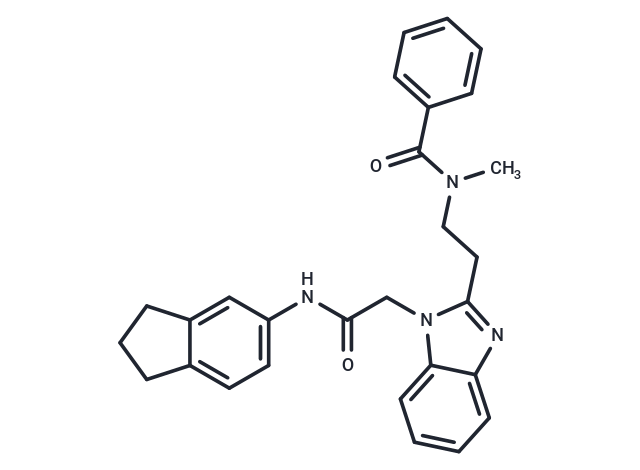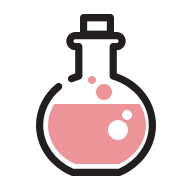- Remove All
 Your shopping cart is currently empty
Your shopping cart is currently empty
Shopping Cart
GSK717
Catalog No. T38361Cas No. 1595278-21-9
GSK717 is a potent, selective NOD2 (nucleotide-binding oligomerization domain 2) inhibitor that inhibits muramyl dipeptide (MDP)-induced NOD2-mediated signaling with an IC50 of 400 nM for MDP-stimulated IL-8 secretion in HEK293/hNOD2 cells[1]. It blocks the synergy between NOD2 and TLR2 without affecting NOD1, TNFR1, and TLR2-mediated responses. At 5 μM, GSK717 inhibits the release of IL-8, IL-6, TNFα, and IL-1β in primary human monocytes stimulated with MDP[1].
[1]. Rickard DJ, et al. Identification of benzimidazole diamides as selective inhibitors of the nucleotide-binding oligomerization domain 2 (NOD2) signaling pathway. PLoS One. 2013;8(8):e69619. Published 2013 Aug 1.

GSK717
Catalog No. T38361Cas No. 1595278-21-9
GSK717 is a potent, selective NOD2 (nucleotide-binding oligomerization domain 2) inhibitor that inhibits muramyl dipeptide (MDP)-induced NOD2-mediated signaling with an IC50 of 400 nM for MDP-stimulated IL-8 secretion in HEK293/hNOD2 cells[1]. It blocks the synergy between NOD2 and TLR2 without affecting NOD1, TNFR1, and TLR2-mediated responses. At 5 μM, GSK717 inhibits the release of IL-8, IL-6, TNFα, and IL-1β in primary human monocytes stimulated with MDP[1].
[1]. Rickard DJ, et al. Identification of benzimidazole diamides as selective inhibitors of the nucleotide-binding oligomerization domain 2 (NOD2) signaling pathway. PLoS One. 2013;8(8):e69619. Published 2013 Aug 1.
[1]. Rickard DJ, et al. Identification of benzimidazole diamides as selective inhibitors of the nucleotide-binding oligomerization domain 2 (NOD2) signaling pathway. PLoS One. 2013;8(8):e69619. Published 2013 Aug 1.
| Pack Size | Price | Availability | Quantity |
|---|---|---|---|
| 1 mg | $35 | In Stock | |
| 5 mg | $81 | In Stock | |
| 10 mg | $129 | In Stock | |
| 25 mg | $242 | In Stock | |
| 1 mL x 10 mM (in DMSO) | $117 | In Stock |
Bulk & Custom
Add to Cart
Questions
View MoreSelect Batch
Purity:99.01%
Contact us for more batch information
With extensive experience in compound synthesis, we can provide rapid custom synthesis services for this product according to your research needs.Product Introduction
Bioactivity
Chemical Properties
| Description | GSK717 is a potent, selective NOD2 (nucleotide-binding oligomerization domain 2) inhibitor that inhibits muramyl dipeptide (MDP)-induced NOD2-mediated signaling with an IC50 of 400 nM for MDP-stimulated IL-8 secretion in HEK293/hNOD2 cells[1]. It blocks the synergy between NOD2 and TLR2 without affecting NOD1, TNFR1, and TLR2-mediated responses. At 5 μM, GSK717 inhibits the release of IL-8, IL-6, TNFα, and IL-1β in primary human monocytes stimulated with MDP[1]. [1]. Rickard DJ, et al. Identification of benzimidazole diamides as selective inhibitors of the nucleotide-binding oligomerization domain 2 (NOD2) signaling pathway. PLoS One. 2013;8(8):e69619. Published 2013 Aug 1. |
| In vitro | GSK717 (5 μM) inhibits the release of IL-8, IL-6, TNFα and IL-1β in primary human monocytes stimulated with MDP. GSK717 inhibits muramyl dipeptide (MDP)-induced NOD2-mediated signaling, with an IC50 of 400 nM for MDP-stimulated IL-8 secretion in HEK293/hNOD2 cells[1]. |
| Molecular Weight | 452.55 |
| Formula | C28H28N4O2 |
| Cas No. | 1595278-21-9 |
| Smiles | CN(CCc1nc2ccccc2n1CC(=O)Nc1ccc2CCCc2c1)C(=O)c1ccccc1 |
| Relative Density. | 1.23 g/cm3 (Predicted) |
Storage & Solubility Information
| Storage | store at low temperature | Powder: -20°C for 3 years | In solvent: -80°C for 1 year | Shipping with blue ice. | |||||||||||||||||||||||||||||||||||
| Solubility Information | DMSO: 250 mg/mL (552.43 mM), Sonication is recommended. | |||||||||||||||||||||||||||||||||||
Solution Preparation Table | ||||||||||||||||||||||||||||||||||||
DMSO
| ||||||||||||||||||||||||||||||||||||
Calculator
In Vivo Formulation Calculator (Clear solution)
Please enter your animal experiment information in the following box and click Calculate to obtain the mother liquor preparation method and in vivo formula preparation method:
Mother liquor preparation method: 2 mg of drug dissolved in 50 μL DMSO (mother liquor concentration of 40 mg/mL), if you need to configure a concentration that exceeds the solubility of the product, please contact us first.
(mother liquor concentration of 40 mg/mL), if you need to configure a concentration that exceeds the solubility of the product, please contact us first.
Preparation method for in vivo formula: Take 50 μL DMSO main solution, add 300 μLPEG300
main solution, add 300 μLPEG300 mix well and clarify, then add 50 more μL Tween 80, mix well and clarify, then add 600 more μLddH2O
mix well and clarify, then add 50 more μL Tween 80, mix well and clarify, then add 600 more μLddH2O mix well and clarify
mix well and clarify
For Reference Only. Please develop an appropriate dissolution method based on your laboratory animals and route of administration.
Dose Conversion
You can also refer to dose conversion for different animals. More Dose Conversion
Tech Support
Please see Inhibitor Handling Instructions for more frequently ask questions. Topics include: how to prepare stock solutions, how to store products, and cautions on cell-based assays & animal experiments, etc
Keywords
Related Tags: buy GSK717 | purchase GSK717 | GSK717 cost | order GSK717 | GSK717 chemical structure | GSK717 in vitro | GSK717 formula | GSK717 molecular weight

Copyright © 2015-2025 TargetMol Chemicals Inc. All Rights Reserved.



